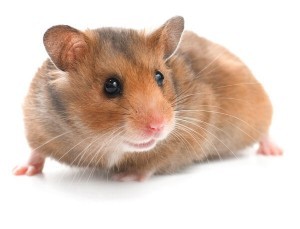Hamster Facts and Statistics
If you are in need of facts about hamsters, here you go. You can find hamster facts on: anatomy structures, behavioral characteristics, scientific terminology and classification, a history time line of hamsters as well as some popular cultural references and other random info.

General Facts and Info

- The hamster belongs to the rodent family (Order: Rodentia).
- There are 26 species and sub species. About 5 are found in the pet world.
- Hamsters have an average lifespan of a 1.5 to 3 years but many live longer (2 yrs = 60 human years).
- Certain states have Anti-Vermin laws that make it illegal to buy or sell them as pets.
- Golden hamsters originate form North of Syria in Turkey
- Dwarf species originate in Russia, Mongolia and China
In pop culture
- The Hamster Dance became one of the first viral pieces of content on the Internet . By: Deidre LaCarte in August 1998.
- in 2008 the movie Bolt
featured an animated hamster named Rhino. Voiced by Mark Walton.
- A Japanese anime series called Hamtaro
was about a hamster who went on adventures with other hamsters called “ham hams” (02-04 in the US)
- Zhu Zhu pets created the children toy Kung Zhu hamsters
in 2010. Additionally, in the fall of 2011 the “Quest for Zhu” animated movie goes to DVD.
- in 2010, Kia releases a series of commercials featuring hamsters driving around in a new Kia Soul while other hamsters run in place in their wheels.
Facts Related to Behavior
- A hamster is a clean animal and will clean and groom itself to stay clean.
- They collect and hoard their food in a safe place.
- The majority of their time is spent underground in their tunnels and burrows (up to 90%).
- They are most active during the twilight hours when the sun is not out.
- Since they eat both plants and small insects or grubs, they are considered omnivores.
- Syrian breeds don’t live well with others; dwarf breeds however can live in communities.
- When they begin to breed, they can have a litter of 4-14 babies within 15-22 days after mating (gestation period).
- Mother hamsters can smell their babies and if thee scent is not normal, they may abandon or eat their young.
- Babies should not be handles until 20 days after birth.
- Some hamster play dead when frightened.
- They are susceptible to many of the same illnesses as humans are (see a list of common hamster illnesses).
- In times of cold temperatures, a semi-dormant state of sleep can occur but not a complete hibernation (below 46*f, 8*c).
Facts about Anatomy
- Cheek pouches on the insides of a hamster’s mouth allow it to gather and transport food.
- The tail is short and stubby except for the Chinese dwarf breed.
- Short legs help hamsters burrow and dig tunnels efficiently.
- Their eyesight is poor (they are nearly color blind; see in greens and yellows).
- Their hearing is exceptional but sensitive as the can hear very high pitches.
- Hamster can use their sense of smell to seek food and recognize other hamsters (scent glands).
- Their incisor teeth will continue to grow like finger nails do, requiring constant wearing by gnawing.
- There are three main coat types: satin, rex and long haired.
- The lungs of a hamster have five lobes unlike our two lobes.
- They have two stomachs to help in the digestion process.
- The Roborovski dwarf is one of the smallest breeds (1.5-2 inches 4-5cm).
- The European breed is the largest but the Syrian is the largest kept as pets at (6-8 inches 15-20cm).
- See more on anatomy and breeds
Scientific Terminology and Classification
- The term “Hamster” originates from the German word “hamstern” which means to hoard
- Mesocricetus auratus (Genus – Species) is the name or the Golden species. It means “medium hamster”
- Phodophus campbelli : Campbell’s Dwarf
- Phodophus sungorus: Winter White Dwarf
- Phodophus roborovski: Roborovski (Robo) Dwarf
- Cricetus griseus: Chinese Dwarf
- Class: Mammals – Mamalia
- Order: Rodent – Rodentia
- Family: Mouse like – Muridae
- Subfamily: Squeaking ones – Cricetidae
- Genra (genus)
- Species: (species)
- More on classifications
History Timeline
- 1773: Chinese Dwarfs were first cataloged
- 1973: The Winter White breed was cataloged. Discovered in West Siberia
- 1797: Was the first mention of the Golden hamster in writing (The Natural History of Aleppo
by Alexander Russell)
- 1839: Was when Goldens were scientifically classified by George Waterhouse (Hamster remains at: Natural History Museum of London, UK)
- 1903: The Roborovski dwarf was first discovered by Dr. K. A. Satunin
- 1919: Chinese dwarfs kept in laboratories
- 1930: Israel Aharoni, a zoologist collected the first living specimens in Syria. (A mother and her babies)
- All pet hamsters are descendents of Aharoni’s hamsters*.
- 1945: First hamster club was formed.
- 1940s: Syrians gained popularity as pets in the US
- 1948: Harvard Medical School acquires two Chinese dwarfs for research
- 1949: National Hamster Council was formed (oldest active hamster organization)
- 1970s: Russian dwarf breed was introduced into the pet market
- 1970s: Winter Whites show up in the pet market in the UK
- 1970s: Campbell’s dwarfs are introduced into the pet market in the Uk
- *1971: Reports of a litter 12 wild hamsters was discovered in Aleppo and later bred.
- 1975: The Institute for Zoology in Halle Germany began to study the behavior of this Golden breed
- 1978: Two females found in Aleppo and brought to the US.
- 1982: A female was discovered in Aleppo and brought to the UK.
- 1980s: Pet dwarf hamsters became available in shops
Random, Weird and Odd Facts
- 2000, over 200,000 hamsters were used in research projects in the United States.
- Researchers used them to help find a cure for Leprosy but hamsters like other animals were resistant to the disease. Armadillos are an exception.
- more to come…
Reviewed By: Tim Winter

Tim Winter has a strong affection for pets and wildlife. His years of experience caring for various types of pets has led him to share his knowledge with others on the best practices in pet care. Tim holds a Bachelor of Science from the University of Oregon School of Journalism and Communications.
